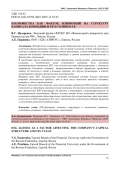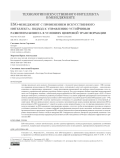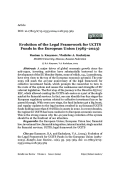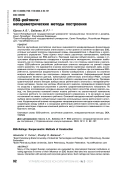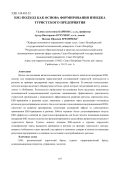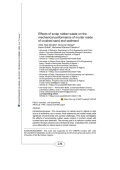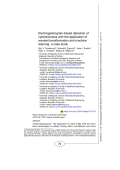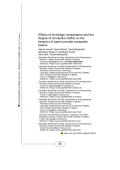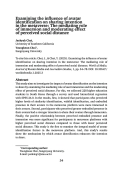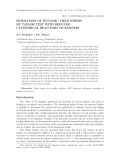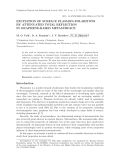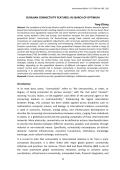Исторически компании в своей деятельности полагались на различные источники финансирования. Очевидно, что на выбор компании между собственным и заемным капиталом влияют многочисленные переменные, состав которых во многом зависит от текущей экономической ситуации и уровня развития экономических и финансовых отношений.
В настоящее время появляются новые финансовые инструменты, стимулирующие компании к достижению целей устойчивого развития. Если компания придерживается принципов ESG, она может получить финансирование с меньшими затратами. Компании, которые придерживаются данной стратегии, проявляют заботу об экологии и людях в большей степени, чем другие организации, а также увеличивается степень прозрачности менеджмента. Выбирая путь ESG, большинство компаний начинают уделять больше внимания решению экологических проблем, что в том числе помогает привлечь клиентов, которые к этому неравнодушны.
Помимо экологической стороны, при использовании стратегии ESG может меняться стоимость и структура капитала самой компании. В основном изменения происходят при привлечении ESG-инвестиций от фондов и инвесторов, специализирующихся на ответственных инвестициях. Выпуск зеленых ценных бумаг позволяет устойчивым компаниям привлекать дополнительные средства для осуществления своих проектов, в том числе и ESG-инициатив. Все это в совокупности может впоследствии привести к увеличению рыночной капитализации.
Авторы преследуют цели научного обоснования наличия у технологий искусственного интеллекта (далее – ИИ) потенциала наращения результативности ESG-менеджмента (англ. environmental, social, and corporate governance – экологическое, социальное и корпоративное управление), а также предложения рекомендаций для наиболее полной реализации этого потенциала в управленческой практике российских бизнес-структур. Для этого авторами обобщен передовой международный опыт топ-50 цифровых экономик с наибольшей распространенностью ESG-менеджмента в деловой среде в 2024 г. В итоге проведен мониторинг устойчивости развития российского бизнеса в условиях цифровой трансформации отечественной экономики, выявивший выдающуюся результативность ESG-менеджмента в деловой среде Российской Федерации (далее – РФ), активное использование ИИ и наличие значительного потенциала его дальнейшего распространения в отечественной деловой среде. Методом регрессионного анализа составлена эконометрическая модель влияния факторов применения ИИ на результативность ESG-менеджмента. С опорой на модель сделан авторский вывод о том, что факторы применения этой технологии оказывают на ESG-менеджмент противоречивое влияние, и для того чтобы оптимизировать последнее в интересах устойчивого развития бизнеса в условиях цифровой трансформации рыночной среды экономики, необходимо увеличивать производительность прикладных алгоритмов ИИ, масштаб национального финансирования развития технологии и стимулировать инициативность бизнеса в области внедрения ИИ. Эмпирическая ценность авторских предложений заключена в том, что они высветили перспективу наращения результативности ESG-менеджмента в РФ через повышение эффективности применения ИИ.
A major driver of global economic growth since the mid-1950s, investing activities have substantially bestowed to the development of the EU Member States, some of which, e.g., Luxembourg, have even risen to the top of the European economic pyramid. The year 2025 will mark the 40-year anniversary of the legal framework for collective investment funds, which prompts the researcher to turn to the roots of the system and assess the weaknesses and strengths of EU relevant legislation. The first stop of the journey is the Directive 85/611/EEC, which allowed creating the UCITS sub-sector as a part of the single market for financial services. In fact, one can identify four key stages the European regulatory system related to collective investment has so far passed through. With every new stage, the fund industry got a big boost, and regular updates to the legal system resulted in 29 thousand UCITS funds holding more than € 8 trillion in assets in 2022. In recent decades, the regime for UCITS has been conducive to European economic success. This is the strong reason why the 40-year-long evolution of the system should be at the forefront of our attention.
Многие крупнейшие российские компании оцениваются международными финансовыми институтами или рейтинговыми агентствами с точки зрения их влияния на факторы ESG, которые учитывают вопросы окружающей среды, взаимодействия с обществом и корпоративного управления. Такие оценки могут иметь различные наименования, наиболее часто упоминаемые как ESG-рейтинги. Присущая оценкам субъективность, наряду с отсутствием общепризнанных стандартов и прозрачности методологии, вызывают озабоченность как со стороны оцениваемых компаний, так и со стороны инвесторов и регуляторов. ESG-рейтинги российских рейтинговых агентств находятся на ранней стадии своего развития, что выражается в малом количестве оцененных компаний. Цель исследования состоит в изучении основных методологических проблем при составлении ESG-рейтингов, выявленные академическим и бизнес-сообществом с фокусом на изучении вопроса выбора весов при построении сводного показателя. Информационной базой исследования являются данные, публикуемые рейтинговым агентством RAEX, которое позиционируется как крупнейшее агентство в области некредитных рейтингов. Проведен сравнительный анализ методик выбора весов рейтингового агентства с непараметрическими методами, такими как методы оболочечного анализа, определения предпочтений по сходству с идеальным решением и расчета среднегеометрического показателя. По результатам исследования исходных данных рейтингового агентства можно сделать вывод, что большинство компаний имеют низкие рейтинги по экологической компоненте и высокие рейтинги по компоненте корпоративного управления, в то же время ни одна из компаний не имеет эталонного рейтинга. Основной методологической проблемой при выборе весов является субъективный характер используемых весов рейтингового агентства. Корреляционный анализ исследуемых непараметрических методов показал высокую корреляцию между собой и с исходными рейтингами рейтингового агентства, однако на уровне некоторых отдельных компаний рейтинги могут отличаться в зависимости от выбранного метода.
Целью исследования является выявление положительного аспекта во внедрении ESG-модели для совершенствования маркетинговой составляющей туристской деятельности в регионе на примере предприятия через определение эффектов. В качестве используемых методов авторы выделяют общенаучные методы, среди которых дедуктивный метод, анализ, синтез и обобщение. В результате проведения исследования были выделены компоненты потенциальной коммуникационной стратегии, связывающие эффективность деятельности туристской организации с повышением эффективности развития региона, определена роль ESG-принципов в решении задач, связанных с развитием через реализацию потенциала региона в рассматриваемом аспекте, была составлена схема влияния коммуникационной ESG-стратегии на развитие предприятия, исследован суммарный эффект от качественного применения ESG-принципов в регионе. Работа отражает более детализированную модель ESG-эффектов и событий на туристском предприятии для более четкого понимания влияния внедрения ESG-модели на качество функционирования и дальнейшее развитие регионального туристского бренда. Удалось описать значение ESG-модели в туризме, определить специфические черты раскрытия принципов в регионе на примере туристского сектора. выявить особенности таких явлений, как прямое и косвенное доверие в контексте изменения репутации предприятия и ее влияние на состояние и востребованность региона.
Introduction/purpose: The consumption of natural sand in Algeria is high due to its extensive use in mortar, while sediments and rubber waste pose significant environmental and societal challenges. This study investigates the effects of incorporating rubber waste content in mortars mixed with crushed sand and sediment. The primary goal is to valorize crushed sand particles through physical and mechanical tests, evaluating their potential as an alternative to natural sand in mortar mixtures.
Methods: Experimental work was carried out to study the impact of partially and fully replacing sediments with crushed sand particles in mortar mixes. Mortar mixtures were prepared using different sediment-to-crushed sand ratios (10%, 25%, 35%, 50%, and 100%) to observe their influence on physical and mechanical properties. Additionally, the effects of adding 2%, 4%, and 6% granulated rubber to the optimal mortar were analyzed. Various tests, including those tsting compressive strength, flexural strength, and ultrasonic pulse velocity, were performed to evaluate the performance of the mixtures.
Results: The results indicated that replacing sediment with crushed sand improved the strength properties of mortar, particularly due to better particle packing. The mortar containing 65 wt% sediments and 35 wt% crushed sand showed properties similar to the reference mortar. The addition of rubber waste increased compressibility but enhanced mechanical properties when used in moderation. Ultrasonic pulse velocity decreased with higher crushed sand content, and the porosity of the mixtures was reduced.
Conclusions: Crushed sand and sediment particles are effective fillers for mortar, ensuring good performance and improved strength. The efficiency of these materials depends on their morphology and genesis. The study demonstrates that crushed sand can be a viable alternative to natural sand, and rubber waste can be used as a reinforcing material in mortar, though its proportions should be carefully controlled to avoid negative effects on mechanical properties.
Introduction/purpose: The application of virtual reality (VR) and simulation technologies in military training offers cost-effective and versatile approach to training enhancement. However, prevalence of cybersickness (CS), characterized by symptoms such as nausea, limits their widespread use.
Methods: This study introduces objective parameters for the detection of CS using three-channel electrogastrogram (EGG) recording from one specific subject and assesses the independence and linear correlation for appropriate channel selection. The paper employs a 3-level discrete wavelet transformation (DWT) on the chosen channel to identify key parameters indicative of gastric disturbances. Furthermore, the paper investigates recovery from CS following VR and examines the application of unsupervised machine learning (ML) for segmenting EGG into baseline and CS, utilizing significant features previously identified.
Results and discussion: The analysis reveals no significant differences across EGG channels and moderate to low linear correlation between channel pairs. The feature selection demonstrates that the root mean square of the amplitude as well as the maximum and mean values of the power spectral density (PSD) calculated on all DWT coefficients, are effective for CS detection while the dominant EGG scale could not indicate CS for any level of decomposition. Furthermore, recovery signs appear approximately 8 minutes after the first VR experience supporting the idea of conducting multiple sessions the same day i. e., intensive VR-based training.
Conclusions: The unsupervised ML shows potential in identifying CSaffected EGG signal segments with feature extraction based on DWT, offering a novel approach for enhancing the prevention of CS occurrence in VR-based military training and other VR-related environments.
Introduction/purpose: Temperature and time-dependent effects such as concrete shrinkage and creep significantly affect the behavior of steel-concrete composite beams. Hence, taking into account the demands brought by these additional effects is necessary. This necessity has resulted in various theoretical and numerical research studies. This article proposes an analytical tool capable of predicting a new redistribution of stresses brought by the combined action of temperature and concrete shrinkage in composite steel-concrete beams in partial shear connection. In this work, the partial shear connection at the steel-concrete interface is taken into account according to the degree of connection (N/Nf).
Methods: This involves reformulating the model proposed in 2024 by Rahal et al analyzing the behavior of composite steel-concrete beams in full shear connection under the effect of temperature and concrete shrinkage. In this present study, the main contribution is the introduction of the effect of the connection degree (N/Nf) at the steel-concrete interface, thus leading to an analytical model capable of predicting additional stresses brought by shrinkage and temperature in composite steel-concrete beams in partial shear connection.
Results: When referred to the model proposed in 2024 by Rahal et al, the results from this current approach are satisfactory. They clearly show that the degree of connection significantly affects the forces brought about by the combined action of concrete shrinkage and temperature.
Conclusion: The results of the present approach and those of the existing model developed by Rahal et al are in good agreement. They clearly show the effect of concrete shrinkage and temperature as a function of the connection degree N/Nf on the behavior of composite steel-concrete beams.
This study aims to investigate the impact of avatar identification on the intention to share by examining the mediating role of user immersion and the moderating effect of perceived social distance. For this, we collected 228 higher education students in South Korea through a survey and used hierarchical regression with SPSS 24.0. In the results, first, it showed that participants who perceived higher levels of similarity identification, wishful identification, and embodied presence in their avatars in the metaverse platform were more immersed in their avatars. Second, participants who perceived greater embodied presence in their avatars had a stronger intention to share their avatars through immersion. Finally, the positive relationship between perceived embodied presence and immersion was more significant for participants in metaverse platforms with higher perceived social distance compared to those with lower perceived social distance. This study is the first to examine the integral model of avatar identification factors in the metaverse platform. And, this study’s results show the mechanism by which avatar identification enhances the intention to share.
A simple method is proposed to estimate the dynamic yield stress of materials using modified Taylor tests for high-velocity impact of profiled cylinders with a reduced diameter of the head part. Assuming the uniformity of deformations and stresses in the head part, formulas are derived for estimating the yield stress and strain rate from the change in the length of the reduced head part, as well as the mass of the sample and the impact velocity. This estimation is verified by comparison with the results of numerical calculations by the SPH method based on the dislocation plasticity model parameterized for cold-rolled oxygen-free copper. It is shown that the stopping time of the sample and the strain rate are reproduced with good accuracy, and the shear strength estimate gives an error that increases with the impact velocity. At velocities that do not lead to deformation of a wide part of the sample (up to 90 m/s in the case under consideration), the error increases linearly up to 30%, which can be taken into account by a correction factor. The proposed estimate, taking into account the correction factor, was applied to analyze the results of previous experiments; the obtained values correspond to the literature data on the rate dependence of the shear strength.
In this work we theoretically analyze the electromagnetic behavior of graphene-based metasurface, consisting on arranged array of graphene stripes, under attenuated total reflection conditions. We investigate surface plasmon-polaritons excitation at terahertz and sub-terahertz frequencies. We show that surface plasmon-polaritons may be excited in the metasurface for some orientation with respect to incident wave plane. Effectivity of surface plasmon-polaritons excitation depends on graphene chemical potential and graphene stripes width. We believe that our results open a new road for graphene metasurface based terahertz devices, such as modulator
Rossiya-Ukraina mojarosining kuchayishi va Rossiyaga qarshi G’arbning keyingi sanktsiyalari Evroosiyo aloqasiga chuqur va keng qamrovli ta’sir ko’rsatdi. Bir tomondan, ushbu holatlar Shimoliy va Markaziy Evroosiyo koridorlarining Xitoy va Evropa o’rtasidagi tranzit yo’llari rolini sezilarli darajada kamaytirdi va dengiz transportiga geosiyosiy omillar ham tahdid solmoqda. Shu bilan birga, Rossiya-Evropa energetika savdo tarmog’i va infratuzilma aloqalari muhim o’zgarishlarga duch kelmoqda, neft va gaz quvurlari tez-tez siyosiylashtirilib, ularga qarshi turish va tahdid qilish kabi maqsadlarda foydalaniladi va shu bilan Evroosiyo aloqasi xavfsizligini buzadi. Boshqa tomondan, bu geosiyosiy o’zgarishlar, shuningdek, Rossiya va Belarus kabi Xitoy va Yevroosiyo iqtisodiy Ittifoqi (EAEU) mamlakatlari o’rtasidagi hamkorlikni chuqurlashtirish, Trans-Kaspiy xalqaro Transport yo’nalishi (TITR, o’rta koridor), Xitoy-Qirg’iziston-Ikkinchi O’rta yo’lakning bir qismi sifatida O’zbekiston temir yo’li va xalqaro Shimoliy-Janubiy Transport yo’lagi (INSTC). Ushbu fonda Rossiya, Xitoy, Qo’shma Shtatlar va Evropa har biri o’zlarining ulanish strategiyalarini ishlab chiqdilar, bu Evroosiyo ichidagi turli sub-mintaqalarning geosiyosiy dinamikasiga qarab “ulanish urushlari” yoki hamkorlikdagi tarmoq qurilishining turli xil o’zaro ta’sir stsenariylariga olib keldi. Shu nuqtai nazardan, Markaziy Osiyoning Evroosiyo ulanishidagi hal qiluvchi roli tobora ommalashib bormoqda va uni Evroosiyo ichida yangi ulanish markazi sifatida paydo bo’lishi va butun qit’ani qamrab oladigan ulanish tarmog’ini qurishga rahbarlik qilmoqda.
